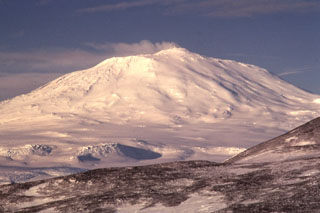Report on Erebus (Antarctica) — December 1986
Scientific Event Alert Network Bulletin, vol. 11, no. 12 (December 1986)
Managing Editor: Lindsay McClelland.
Erebus (Antarctica) Frequent explosions from lava lake
Please cite this report as:
Global Volcanism Program, 1986. Report on Erebus (Antarctica) (McClelland, L., ed.). Scientific Event Alert Network Bulletin, 11:12. Smithsonian Institution. https://doi.org/10.5479/si.GVP.SEAN198612-390020
Erebus
Antarctica
77.53°S, 167.17°E; summit elev. 3794 m
All times are local (unless otherwise noted)
Video surveillance showed that the lava lake that was first sighted in 1963 and has occupied the crater since 1972, remained active during the austral summer of 1986-87. From mid-November through early January about two strong eruptions were recorded/day. The center of the lava lake was continuously active and almost all eruptive activity occurred within the nearly 50-m-wide lake. During eruptions the active area bulged up, then exploded, throwing bombs to hundreds of meters height. Earthquakes accompanied even the small explosions. Present activity was similar to that of previous years, except that the vent above the lava lake was no longer active.
The inner crater floor and lava lake were being monitored by a black-and-white, heat-sensitive, mounted camera that transmits continuously to Scott Base, where data are recorded for at least 4 hours/day. The camera is expected to operate well into the Antarctic winter before the batteries fail.
Further Reference. Kaminuma, K., and Dibble, R., 1988, An eruption process of Mt. Erebus, Antarctica: Proceedings, Kagoshima International Conference on Volcanoes, p. 66-70.
Geological Summary. Mount Erebus, the world's southernmost historically active volcano, overlooks the McMurdo research station on Ross Island. It is the largest of three major volcanoes forming the crudely triangular Ross Island. The summit of the dominantly phonolitic volcano has been modified by one or two generations of caldera formation. A summit plateau at about 3,200 m elevation marks the rim of the youngest caldera, which formed during the late-Pleistocene and within which the modern cone was constructed. An elliptical 500 x 600 m wide, 110-m-deep crater truncates the summit and contains an active lava lake within a 250-m-wide, 100-m-deep inner crater; other lava lakes are sometimes present. The glacier-covered volcano was erupting when first sighted by Captain James Ross in 1841. Continuous lava-lake activity with minor explosions, punctuated by occasional larger Strombolian explosions that eject bombs onto the crater rim, has been documented since 1972, but has probably been occurring for much of the volcano's recent history.
Information Contacts: R. Dibble, Victoria Univ.

